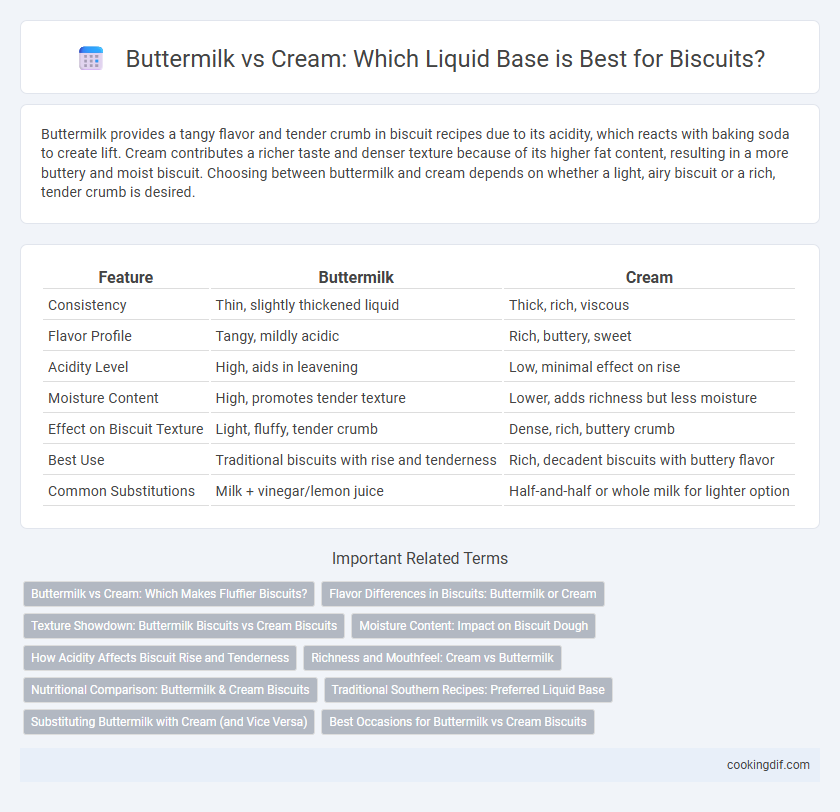Buttermilk provides a tangy flavor and tender crumb in biscuit recipes due to its acidity, which reacts with baking soda to create lift. Cream contributes a richer taste and denser texture because of its higher fat content, resulting in a more buttery and moist biscuit. Choosing between buttermilk and cream depends on whether a light, airy biscuit or a rich, tender crumb is desired.
Table of Comparison
| Feature | Buttermilk | Cream |
|---|---|---|
| Consistency | Thin, slightly thickened liquid | Thick, rich, viscous |
| Flavor Profile | Tangy, mildly acidic | Rich, buttery, sweet |
| Acidity Level | High, aids in leavening | Low, minimal effect on rise |
| Moisture Content | High, promotes tender texture | Lower, adds richness but less moisture |
| Effect on Biscuit Texture | Light, fluffy, tender crumb | Dense, rich, buttery crumb |
| Best Use | Traditional biscuits with rise and tenderness | Rich, decadent biscuits with buttery flavor |
| Common Substitutions | Milk + vinegar/lemon juice | Half-and-half or whole milk for lighter option |
Buttermilk vs Cream: Which Makes Fluffier Biscuits?
Buttermilk creates fluffier biscuits compared to cream due to its acidic content, which reacts with baking soda to produce carbon dioxide bubbles that help the dough rise. Cream contributes to a richer texture and tenderness but lacks the acidity needed for optimal leavening. For maximum fluffiness, using buttermilk as the liquid base enhances biscuit lift and crumb structure.
Flavor Differences in Biscuits: Buttermilk or Cream
Buttermilk imparts a tangy, slightly acidic flavor to biscuits, enhancing their depth and complementing savory fillings, while cream provides a richer, smoother taste with a buttery undertone that creates a tender crumb. The acidity in buttermilk also reacts with baking soda to produce extra lift and a light, fluffy texture. Cream-based biscuits are denser and creamier, appealing to those who prefer a decadent and subtly sweet biscuit experience.
Texture Showdown: Buttermilk Biscuits vs Cream Biscuits
Buttermilk biscuits deliver a tender, flaky texture due to their acidity, which reacts with baking soda to create lift and air pockets. Cream biscuits, using heavy cream, result in a richer, denser crumb with a buttery mouthfeel. The choice between buttermilk and cream fundamentally influences biscuit crumb structure, tenderness, and moisture retention.
Moisture Content: Impact on Biscuit Dough
Buttermilk contains higher moisture content compared to cream, which directly affects biscuit dough hydration and texture. The increased water in buttermilk promotes gluten development, resulting in tender, flaky biscuits with a moist crumb. In contrast, cream's lower moisture and higher fat content yield richer biscuits but may produce a denser, less tender texture due to reduced dough hydration.
How Acidity Affects Biscuit Rise and Tenderness
Buttermilk's acidity reacts with baking soda to produce carbon dioxide, creating more lift and a lighter, airier biscuit texture compared to cream, which lacks this acidic component. The acid in buttermilk also helps tenderize the gluten in the flour, resulting in a softer crumb and enhanced moistness. Cream, being less acidic, yields a denser biscuit with less rise and a firmer texture.
Richness and Mouthfeel: Cream vs Buttermilk
Cream provides a richer, velvety mouthfeel in biscuits due to its higher fat content, which enhances moisture and tenderness. Buttermilk contributes a tangy flavor and slightly lighter texture, with acidity that tenderizes the dough and promotes a delicate crumb. Choosing cream results in indulgent softness, while buttermilk balances richness with a subtle tang, affecting overall biscuit density and flavor complexity.
Nutritional Comparison: Buttermilk & Cream Biscuits
Buttermilk biscuits contain fewer calories and less fat compared to cream-based biscuits, making them a healthier option for those monitoring their intake. Buttermilk provides beneficial probiotics and a slightly tangy flavor, which can aid digestion, while cream adds richness and higher saturated fat, contributing to a more indulgent texture. Nutritionally, buttermilk is lower in cholesterol and saturated fat, whereas cream biscuits offer more calories and fat, impacting heart health considerations.
Traditional Southern Recipes: Preferred Liquid Base
Traditional Southern biscuit recipes favor buttermilk as the liquid base due to its acidity, which reacts with baking soda to create a tender, fluffy texture. Cream, while richer and providing a denser crumb, is less common in classic Southern biscuits where buttermilk's tang enhances flavor and promotes optimal rise. The lactic acid in buttermilk also contributes to a distinctive taste and light crumb, making it the preferred choice for authentic Southern biscuits.
Substituting Buttermilk with Cream (and Vice Versa)
Buttermilk contributes a tangy flavor and acidity essential for activating baking soda in biscuits, creating a tender crumb, while cream offers higher fat content, resulting in richer, flakier textures but less rise due to lower acidity. When substituting cream for buttermilk, adding a tablespoon of lemon juice or vinegar per cup provides necessary acidity for leavening. Replacing buttermilk with cream alone may require additional acid to maintain biscuit structure, whereas swapping cream with buttermilk reduces fat, impacting tenderness and mouthfeel.
Best Occasions for Buttermilk vs Cream Biscuits
Buttermilk biscuits are ideal for savory meals like breakfast sandwiches and Southern-style dinners due to their tangy flavor and tender crumb that pair well with salty, spicy dishes. Cream biscuits, rich and tender with a slightly sweeter profile, excel as a versatile option for brunches, tea-time gatherings, or paired with sweet jams and honey. Choosing between buttermilk and cream bases depends on the occasion's flavor profile, with buttermilk enhancing rustic comfort foods and cream adding richness to elegant or sweet accompaniments.
Buttermilk vs Cream for liquid base Infographic

 cookingdif.com
cookingdif.com